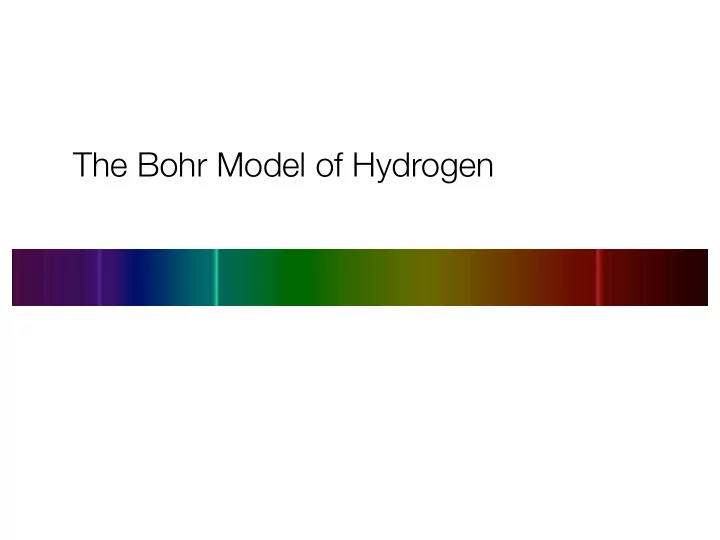

The Bohr Model of Hydrogen
Exam Details • The exam will be held Wednesday, October 5th from 3:35–4:30pm. • I will be away that entire week . Chris will be giving the exam review lecture on Monday. • A practice exam has been posted on the website. The answers will be given in class. • Recitations will not be held the 6th and 7th. Physics 273 – Bohr Model of Hydrogen 2
More Exam Details • The exam will be multiple choice and consist of 16 questions. • Please bring a #2 pencil. • You may bring one 8 1/2” x 11” sheet of paper with formulas and notes. Physics 273 – Bohr Model of Hydrogen 3
Pre-Quantum era questions about the Hydrogen Atom Why does the Rydberg formula work? Why is the absorption the same as the emission spectrum? Why is the ionization energy of Hydrogen 13.6 eV? Why is the atom stable in the first place? Physics 273 – Bohr Model of Hydrogen 4
Recall what would happen if we apply classical electromagnetism to an electron orbiting a proton. Coulomb’s Law binds electron to proton, but the electron is accelerating. An accelerating electron emits electromagnetic radiation (this is an unavoidable consequence of Maxwell’s equations). Eventually (10 -9 seconds) the electron loses enough energy through radiation that is collides with the proton. 4 ⇡✏ 0 r 2 = mv 2 q 1 q 2 F = r Physics 273 – Bohr Model of Hydrogen 5
Bohr introduces his model of the Hydrogen atom in 1913. Assumption 1: the electron can only be in circular orbits whose orbital angular momentum is quantized: L = mvr = n h n = 1 , 2 , 3 , ··· 2 π = n ~ Assumption 2: An electron can spontaneously jump to a lower orbit. In doing so, a photon is emitted, whose energy equals the di ff erence in energy between the two orbits. Physics 273 – Bohr Model of Hydrogen 6
So what does this mean? E n = − mc 2 α 2 2 n 2 Energy is not only quantized, but it has a ground state (n=1) below which the photon cannot fall. ✓ 1 ◆ 2 1 E 1 ≈ − (0 . 511 MeV) 2 = 13 . 6 eV 137 So we have shown that the Hydrogen atom is stable and it’s ground state is the measured ionization energy . There are also excited states (n>1). Let’s compare to the Rydberg equation. Physics 273 – Bohr Model of Hydrogen 7
The energy of a photon when a Hydrogen atom de- excites from one state to the next is ✓ 1 λ = E U − E L = − mc 2 α 2 ◆ E γ = hc − 1 n 2 n 2 2 U L Solving for the inverse wavelength, we get ✓ 1 ✓ 1 λ = − mc α 2 ◆ ◆ 1 − 1 − 1 ≈ − 0 . 01097373 nm − 1 n 2 n 2 n 2 n 2 2 h U L U L But R H =0.01096776 nm -1 That’s really close, but can we do even better? Physics 273 – Bohr Model of Hydrogen 8
In fact the electron and the nucleus are revolve around a common mass (the nucleus is not infinitely massive, although, compared to the electron, it’s close). Replace mass in the equation with the reduced mass : mM µ = m + M where M is the mass of the nucleus. Once you do that, you get precisely the Rydberg constant (M=M proton ). R H = − µc α 2 ≈ 0 . 01096776 nm − 1 2 h Physics 273 – Bohr Model of Hydrogen 9
To recap, from two assumptions, we have recovered the full atomic spectrum of hydrogen! Physics 273 – Bohr Model of Hydrogen 10
Pre-Quantum era questions about the Hydrogen Atom ✓ Why does the Rydberg formula work? ✓ Why is the absorption the same as the emission spectrum? ✓ Why is the ionization energy of Hydrogen 13.6 eV? ✓ Why is the atom stable in the first place? Addressed by the Bohr model. But the Bohr model is just that: a model. Why should the angular momentum be quantized in the first place? The answer will come with quantum mechanics. Physics 273 – Bohr Model of Hydrogen 11
Deficiencies in the Bohr Theory • Many of the energy levels in the hydrogen are actually doublets, i.e. two levels closely spaced in energy (wavelength). Bohr’s theory cannot accommodate this. • Quantization is simply assumed, but not derived. • Spectra of more complicated elements (with more electrons) cannot be explained. • Bohr theory is not relativistic. since v~c/137, it’s not so bad, but we know it can’t be a complete picture. Physics 273 – Bohr Model of Hydrogen 12
The discovery of deuterium (Urey, 1932) Natural hydrogen is 1 part in 6000 deuterium (nucleus has one proton and one neutron, i.e. a deuteron). So the reduced mass of deuterium is a little bit di ff erent than regular hydrogen. mM H µ H = = 0 . 999456 m m + M H mM D µ D = = 0 . 999728 m m + M D The well known Balmer line (n=3 to n=2 transition) has wavelength 656.5 nm. But for deuterium, it is 656.3 nm ! In natural hydrogen , the regular emissions lines are accompanied by very faint lines from deuterium! Physics 273 – Bohr Model of Hydrogen 13
Recommend
More recommend